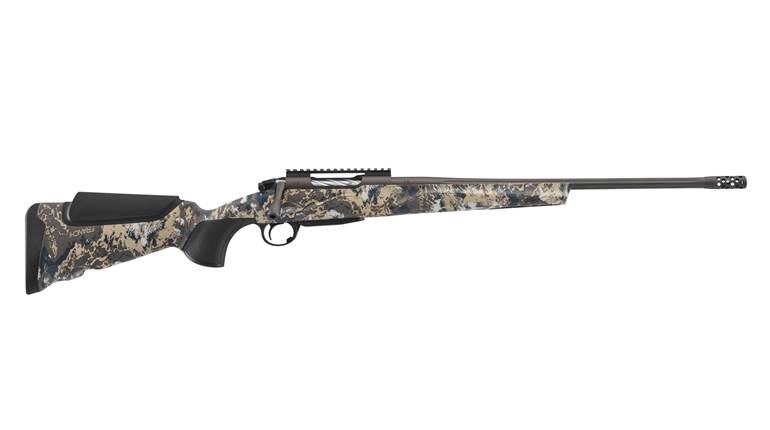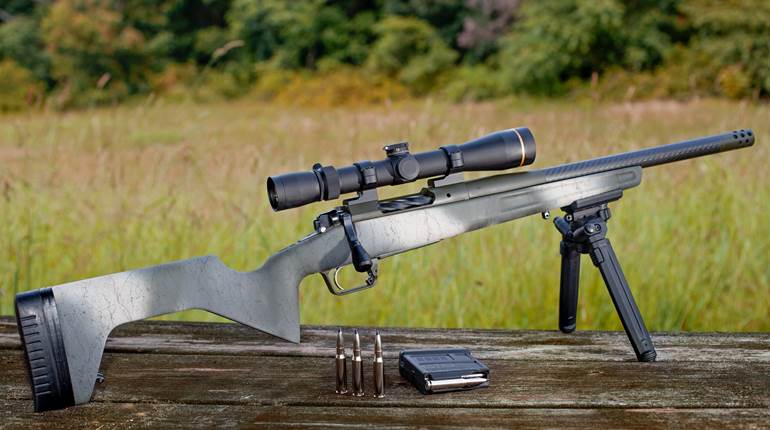
Great stories have been passed down through the years at American Rifleman, and some of them take on the stuff of legend. Take, for example, former Rifleman Editor Walter J. Howe wordlessly smashing a coffeepot with repeated blows from a hammer because too many staffers congregated around it for far too long (which apparently reduced productivity). In Howe's defense, they had been repeatedly warned.
Then there's the saga of former NRA Publications Executive Director George Martin's quest for a minimalist, lightweight dangerous game gun. Martin, an experienced African hunter willing to take a bit of pounding for the sake of an easier-carrying, lightweight dangerous game rifle in .458 Win. Mag., had a delightful, petite gun with a nice stick of custom-made walnut. Time and exaggeration have reduced its weight through the years to a mere 6 ½ lbs., a rifle that would literally dance in your hands. When handloads were being worked up, legend has it, the elegant little rifle exploded in a shower of splinters, leaving it shattered and broken clean through at the wrist. In a recent conversation with George, now retired, the story is just that—a story—one that has no basis in fact. The actual rifle, a 10¼-lb. Whitworth in .375 H&H built by Dave Yale (February 1984, p. 28), made two safaris with George and then, with recoil reducers, was used in Africa by his petite and elegant wife Mary.
True or not, I've always kept that story in mind every time I look at a lightweight, hard-recoiling gun. And the new Kimber Talkeetna—chambered in the "medium-bore".375 H&H Mag., the minimum for hunting the "big five" in Africa and an ideal cartridge for big Alaskan bears—fits the description of a lightweight heavy hitter very well indeed. In a trend pioneered by Ultra Light Arms' Melvin Forbes, extremely light or "mountain" rifles have become all the rage; they're not just for sheep hunters anymore. My opinion of synthetic-stocked rifles has moderated through the years. At one time, I wouldn't have such a contrivance in my house, let alone in my gun safe. In short, because of Forbes, I'm a convert and believe Kimber's .308 Win. 84M Montana sets the standard for the class in lightweight
American-made production rifles. But dangerous game rifles are different. A magazine rifle in .375 H&H Mag. or better needs weight to tame recoil. Many authorities give an ideal weight of around 10 1/4 to 10 ½ lbs. Named for a town that begins many a backcountry Alaskan adventure, the Model 8400 Talkeetna shaves about 2 lbs. off the "ideal" number, weighing in at 7 lbs., 9 ozs. unscoped. With a Leupold VX-7 1.5-6X 24 mm and accompanying steel Talley bases and rings, the rifle tips the scale at 8 lbs., 13 ozs. So is the Talkeetna too light? The answer is an unequivocal "no." Does it kick? Yes, briskly. Can it be managed? Yes, quite well. And can it be carried comfortably? Yes, all day every day.
If there is such a thing as an all-around cartridge, it is likely the .375 H&H Mag., which dates to 1912. In his 1936 book Big Game Rifles And Cartridges, and after praising the .350 Griffin & Howe Magnum and the .350 Newton (good luck finding brass), Elmer Keith wrote the following about the .375 H&H: "The .375 Magnum will do the same thing at any range needed on big game, and is also one of our most reliable rifles for larger game. It will also kill the smaller game cleanly, with little waste of meat, if the shots are placed where they should be whenever possible… One's choice of these larger caliber weapons is mainly a personal one, and one subject to the individual choice as regards the weight the user cares to carry. "For me, after having carried far heavier rifles in the game fields of Alaska and Africa, the scoped Talkeetna, at slightly less than 9 lbs., is a rifle I indeed "care" to carry. Most hunting rifles are carried a lot and shot a little, but even then recoil has to be manageable, as a rapid second shot is often required, and you need to be more afraid of an animal that can maul or gore you than the recoil of your rifle. The Talkeetna's stock design makes that possible.
More Than The Right Lines
The wood-stocked and blue Kimber Caprivi (November 2007, p. 52) in .375 H&H weighed in at 8 lbs., 12 ozs, unscoped—15 ozs. more than the Talkeetna. Most of the weight savings comes from the latter's Kevlar and carbon fiber stock, which—with its aluminum trigger guard—weighs a mere 1 lb., 15 ozs. Aside from its obvious weather resistance, the stock's excellent ergonomics allow the Talkeetna to be a very bearable rifle to shoot. The gun's straight comb doesn't transmit recoil to the cheek, as the gun slams straight backward, not up and into the cheek. Too, the pistol grip has a generous open radius, allowing a firm grip on the rifle while giving one enough space so the knuckles aren't rapped in recoil. While minimalist and trim through the fore-end and grip, the butt has a larger footprint than a standard Model 8400 Montana, as well as an 11/16"-thick Pachmayr XL Decelerator recoil pad, giving it more surface to spread out the recoil. The comb is of a compromise height in the straight American style, perhaps slightly better suited to a low optical sight than the supplied iron sights, although it works well with both. The rifle's handling dynamics are simply excellent, it balances well, carries well and virtually leaps to the shoulder.
The stock has a gentle, almost subtle, shadbelly shape forward of the trigger guard where the magazine area is expanded to accommodate four rounds of .375. Inside the blind magazine, there's a steel box that engages recesses cut for it in the underside of the receiver. The follower is aluminum, and tension is provided by a W-shaped flat spring.
A Trim, Proven Action
The basics of the Talkeetna follow that of the Model 8400 Caprivi, but are rendered in stainless steel. As a matter of fact, the only blued parts are the sights, the internal magazine body and spring, and some of the single-stage trigger parts. The 8400's cylindrical receiver is 1.37" in diameter at its ring, and there is a gas relief hole in its right side. The action port is 3.512" in length to accommodate the .375 H&H, which has a maximum cartridge overall length of 3.600". The dual-opposed locking lug bolt has a body 0.68" in diameter. The lugs are tapered and measure 0.49" high and 0.42" wide. There are two gas-relief holes in its underside, and there's one on the receiver's right as well. The claw extractor is on the bolt's right and is 4.8" in length; its front face is 0.45" high, and its face measures 0.290" across at its widest point. The root of the bolt handle serves as a third locking lug. On the receiver's rear left is the bolt stop; depressing it allows bolt removal to the rear. A three-position, Model 70-style wing safety is on the bolt shroud's right. The blade ejector is mounted in a slot in the receiver's left rear bottom, and a coil spring at its rear pops it back up into the case's path as the bolt is drawn rearward. A corresponding cut for it is in the bolt face at four o'clock when viewed from the front.
The recoil lug, sandwiched between the receiver and barrel when the latter is screwed into place, measures 0.226" deep and is 1.05" wide. On the test rifle, the lug was well glass-bedded, then, oddly, the bedding was painted over in the same gray as the rest of the stock. Two screws, which have aluminum pillars chamfered to meet the inside contours of the screw heads, secure the action to the stock. One passes through the rear of the aluminum trigger guard while the other threads into the bottom of the receiver ring.
A Barrel With The Right Features
The 24" long magnum contour barrel tapers from 1.241" in diameter forward of the receiver ring to 0.703" at the muzzle, which has a dished target-style crown. The barrel is not free-floated, as there was constant pressure for the first 3½" from the fore-end's front. A stainless front barrel band 9¾" back from the muzzle accepts a quick-detachable sling swivel stud. This isn't just for looks, as it keeps the weak hand from being rapped under recoil by the front stud and sling swivel. It is, however, undeniably cool. Kimber didn't skimp on the Talkeetna's sights, as both the front and rear are from New England Custom Gunsmith Service. The NECG Classic Adjustable Rear isn't the express style as found on the Caprivi, but its base is screwed to the barrel and windage adjustment is by drifting the dovetailed sight. The elevation of the notch rear is manipulated after loosening two set screws on the rear face of the sight then retightening them. The NECG ramp front features a white bead, as well as a hood.






































